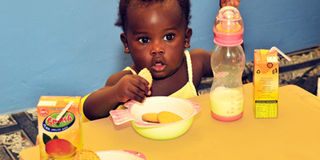Is your child getting the best food nutrients?

Supplement your child’s diet with foods rich in nutrients such as fruits and vegetables. For example, give them a mashed banana mixed with yogurt.
What you need to know:
What foods are you giving your child? Nutritionists say children require different types of food during the various stages of their growth. These foods should contain nutrients such as vitamins and proteins. We explore some of the foods that could benefit your child.
All babies at different stages of life require several nutrients including protein, carbohydrates, fats, minerals and even water for proper growth and development.
These foods should also be eaten in the right quantities for them to be effective.
Feeding children with the proper foods will ensure that they will grow up healthy and strong. Good nutrition also prevents children from developing infections and diseases, as it will boost their immunity. Jennifer Mugisha, a national nutritional advisor with Strides for Family Health, recommends the following foods for children in the different age groups.
Zero to six months
Children in this age group should be exclusively breastfed, since breast milk has all the nutrients that babies need. According to Mugisha, although all babies like breast milk, they may become disinterested in it if their mothers introduce them to other foods at an early age.
Eventually, they may get used to these foods and refuse the breast milk. “If the mother cannot breastfeed the baby because of medical reasons for instance, she is infected with HIV/ Aids, the alternative is to feed them on formula milk instead. Since there are various milk formulas for babies on the market.
“It is better to consult a doctor first before buying one,” says Mugisha.
Seven months to one year
As much as the child is still breastfeeding at this stage, a mother can go ahead to supplement the baby’s diet by introducing them to solid food. It is important to note that all kinds of foods are good for the baby. However, it is vital to give the right amounts. These foods should also be mashed thoroughly, as the baby’s digestive system is still delicate.
For instance, if one is feeding the child on Irish and sweet potatoes, matooke (bananas), pumpkin or rice, they should be mashed properly. “If it is meat or chicken, break it into little pices and then add it into any other kind of gravy such as groundnut paste,” explains Mugisha.
Mothers should note that it is important to feed the baby from time to time, say five times a day since they have smaller digestive systems that take in reduced amounts of foods. Feeding them at various time intervals also allows the mother to give the child different types of foods, with varied nutrient levels.
Two to three years
At this stage, a child is developing teeth and the mother can therefore start giving them small amounts of whole foods so that they can learn how to chew on their own. For instance, instead of mashing a boiled egg, one can cut it into small pieces and then give the child to eat.
Perhaps if it is a fruit like a mango, wash the whole of it thoroughly well, cut some part of it and then give to the child to eat on their won. If the child is finding difficulties chewing the food, there is absolutely no problem with continuing to feed them on mashed food. It is at two years that some mothers may stop breastfeeding their children. Others may go on to breast feed until the child makes three.
Over four years
At this stage, a child can now be given any kind of food to chew on their own.
Mothers may also more often enrich their children’s diets with foods that are rich in vitamins.
For example, if a child has started kindergarten, the mother could blend fruits such as mangoes, pineapples, apples and paw paws together and then pack in a bottle for the child to drink during the course of the day. Not only does this boast a child’s health, it is also keeps them energised throughout the day.
In case you are a mother and are still finding trouble on what to feed your child at particular age, simply follow the above advice as recommended by the nutritionist.




